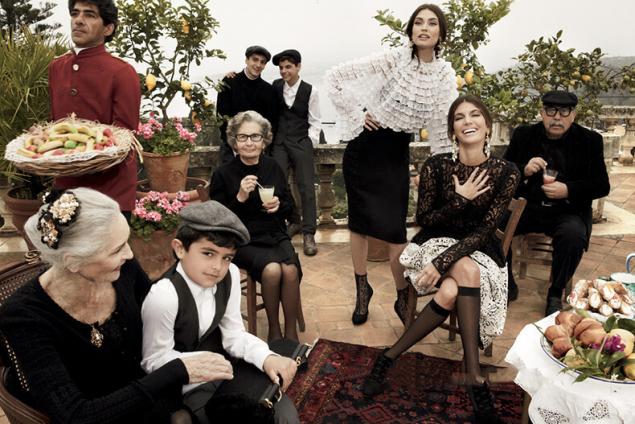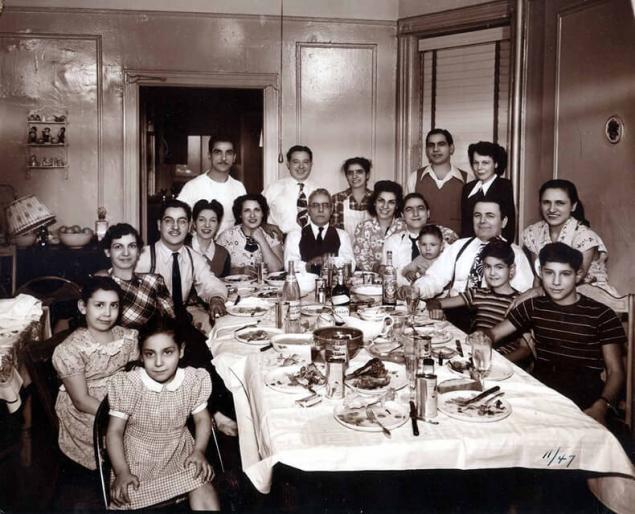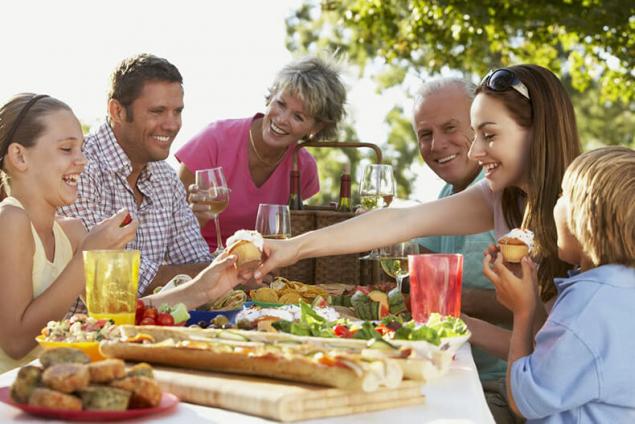569
The relationship of food and oxytocin, the body contact is laid in childhood!
Mealtime is one of the most taboo areas of life. For thousands of years of history all his life people were eating in the company of their loved ones. The child's mother, an adult in a circle of fellow man among households. The refusal to share food was one of the most terrible punishment.
Of course, such close contact was accompanied by physical contacts and conversations. It is not surprising that one of the most important hormones that regulate our behavior, oxytocin also directly associated with food intake.
The relationship of food and oxytocin, the body contact is laid in childhood, when suckling the nipple stimulates the receptors, causing release of oxytocin. That is why the food alone, food without "contact", food, when each by itself leads to overeating.
Food with close contact and conversation help reduce appetite and amount of food eaten, better saturation, reduce stress and unite people. Unfortunately, the Internet is full of battle-paleo and vegan, but we're still not used to consider health in the context of culture.

The ritual of eating and oxytocin.
When you gather with loved ones and nice people, contact them. talking to the hypothalamus of the brain throws out the blood of his hormone – oxytocin, which leads to good health and positive attitude to the world.
This is a very important protective hormone which is responsible for our health and protects us from stress. Oxytocin creates trust and favorable location to other people (only friends, not to all!). Now we are trying to understand the mechanisms of its action.
Thus, oxytocin stimulates the vagus (vagus nerve) and effectively suppresses the hunger and reduces the amount of food eaten as normal and leptin-resistant givotnyh in the experiment. In humans, intranasal oxytocin reduces the amount of food eaten with no effect on his reflexes, and without affecting blood glucose levels. So if you feel lonely, you will eat more. If you have a deficit of social contacts, you will eat more.

In the primitive time sharing food served as a means of survival, security and fullness of each member of the family. In those days food was a little, therefore the piece of food could be saved from hunger and death.
The process of eating mostly traditionally done all together. This is a distinctive feature of the person, for though other species of animals feed their children, adult animals usually eat individually.
But chimpanzees after a successful hunt behaves as most of the hunters: they are scurrying around to get some part of production or hope that will remain. Share your food – so, in some sense, to enter into a social contract for action, including self-restraint, and most of this happens during a meal of large animals and the use of appropriate tools.
"Lovers of fruit there is no need to develop these chivalrous instincts." Hunters and gatherers are divided animals killed among themselves. Despite the emergence of catering, food at home was a sign of wealth. The Romans with middle and high social status eating house: the food was very expanded, but served mostly the lower social strata.
Ritual food and social environment
Earlier, the family meal was one of the ways of upbringing of the younger generation. During a joint meal the whole family gathered, where the older taught the younger, gave them instructions and advice. So from the instinct of self-preservation, communal meal turned into a beautiful family ritual. Earlier rejection of a shared meal was considered an insult.
Unfortunately, in modern families, this abutment is not so popular. For example, the American family rarely together at the dining table. The facts speak for themselves: the average American one out of five eats in the car; one in four Americans, at least, once a day eats fast food; the majority of American families, according to them, all get together at the same table at least five times per week.
In one study, published in the European Congress on obesity read as follows: children who, at least twice a week eat separately from their parents, 40% more likely to be overweight compared with other children.
In contrast, as reported in the study conducted by the National center on addiction and substance abuse at Columbia University, children involved in family breakfasts, Lunches and dinners five or more times a week, there is less of a problem with drugs and alcohol; such children eat more healthy food, learn better and support more trusting relations with their parentsthan those who rarely appears at the common family table.


The negative consequences associated with the fact that people take food apart, arise mainly for two reasons.
Firstly, when we eat outside the home, especially in a cheap fast food or take food on the Vinowith (namely, eat well most of the kids outside the house), we usually eat not very healthy food. As noted by Michael Pollan (Michael Pollan) in his new book, "dinner is served" (Cooked"), meals eaten outside the home tend to be less useful than homemade food because they are higher in fat and salt. In addition, they are high in calories.
There is another reason: if a person eats alone, it leads to his alienation. The dining table can act as a unifier, family centre as a mini-community. Participation in a joint feast gives the opportunity to meet and talk with relatives to make a break and take a breath. But Americans often put efficiency above fun (the average American works in a year, almost 220 hours more than the average Frenchman).
In many countries, mealtime is sacred. For example, in France, where not forbidden to eat alone, not to eat quickly, and a man with an appetite absorbing the salad in a subway station, passers-by will look with contempt. Besides, the lunch break in France lasts at least one hour. In many Mexican cities, the locals are trying to get out in parks and town squares to eat together with family and friends. In Cambodia, villagers are also eager to share your lunch together with friends and family, which spread a variegated mats and put them brought food.
To sit down together at the dining table means to put aside all differences, so for lunch prohibits discussion of problems causing acute contradictions. Dining table is a place of healing, where opponents offer each other something universal. This is the place where "fed" attitude, and a mutual exchange of warmth. One Rabbi once said that you wished after death to be buried inside his dining room table, for this table, he experienced the happiest moments in my life.

The table is traditionally a place of increased attention to socialization of children: where they must learn self-restraint, to see differences and know the rules of the community; the table of our childhood is often the place where memories focus on the family. Remaining from childhood negative feelings at the table can lead to social phobia in relation to a joint meal or stay at the restaurant.
In his book "Dine with friends" (Eating Together) Julier Alice (Alice Julier) says that dinner in the company of loved ones can greatly affect the relationship between people, it blurs the boundaries between people, as participants of a feast, as a rule, are not inclined to make a distinction between members of different races, genders, and social backgrounds, and it is hardly possible in other settings.
But there were times when even Americans appreciated a good society for the family table and ate sedately. In 1950, Elizabeth David (Elizabeth David), in those days recognized a charming preacher American cuisine (Elizabeth resembles our present guru Alice waters [Alice Waters] or David Lebovich [David Lebovitz]) published "a Book of Mediterranean food". Delicious food, in her opinion, the food is simple.
According to Elizabeth David, a good dish is born not in the minds of creative and trendy restaurateurs, and the most delicious dish that you share with nice people. In one particularly vivid passage, David writes: "In the shade of the lemon trees broke off a hunk of bread, sprinkling it with his admirable flavored olive oil, and drained a glass of tart white wine from the island of Capri, I suddenly remember a saying of Norman Douglas: we should always thank those who helped us better understand reality".
Formula the physical and mental well-being proposed by Elizabeth David, is simple: eat simple food and not alone.
There are healthier.
Scientists from the University of Leeds found that even one joint meal per week has a positive effect on children's attitudes toward vegetables and fruit. The researchers conducted the survey, which involved 2 389 children pupils 52 London schools. The survey revealed that almost two-thirds of students (63%) do not use recommended by the world health organization daily servings of fruit and vegetables – 400 grams. Children who reported that family dinners in their family is not uncommon, consumed on average 125 grams of vegetables and fruits more than those students who in the family has never practiced family meal.

Constant hunger and loneliness.
In man as a social being, historically developed in large groups of genetically entrenched the need for constant communication with their own kind. Therefore, the loss of contact with other people, long periods of loneliness are a serious frusteri factor. Communication with oneself becomes especially acute under conditions of solitude.
We never eat alone, food is always a social act. Now often people eat with smartphones, i.e. they can be sort of together, but apart is. At all times – food is social action. The ancients knew that the eats alone. That is why the food alone, food without "contact", food, when each by itself leads to overeating. Food with close contact and conversation help reduce appetite and amount of food eaten, better saturation.
Recently, experts from Ohio state University conducted a study to examine the relationship between loneliness, hunger and the level of ghrelin (the hunger hormone). After eating, he invariably falls – the question is when it starts to grow. The study involved 42 women. Those of them who consider themselves lonely, ghrelin appeared in the blood faster.
Unfortunately, many people using food tend to fill not only the stomach but the emotional void. It is about those who eat because of feeling lonely who have no one to share my impressions and thoughts, telling about important events. For example, the part of overweight people confuse the sensations of physical hunger and the experience of loneliness. Why? Because both of these feelings – of hunger and of loneliness is felt in the abdomen, and they both mean the lack of.

No wonder that some people, in such circumstances, the difficulty of determining subtle differences in sensation, to reliably distinguish one from the other. After all, hunger is a signal that the body needs food as a source of energy and building materials. And the experience of loneliness is a more complex phenomenon, consisting of views, what should be the communication of the experience and (experience) assessment. When experience does not match with the views, there is estimated the feeling of "I miss".
If people confuse these feelings, then, experiencing loneliness, he can eat instead of chat with old friends or find new ones.But no food will satisfy the need to communicate, and people will still feel that sense of lack. And keep eating again and again, while remaining "forever hungry" and to gain, in the end, excess weight.

"First ask such a person to remember when he had a trusting relationship, or when he was with good friends, and he felt hungry as had not eaten for some time, and keep track of these feelings in great detail...
Then ask him to recall his feelings when he ate the right food, but was lonely and felt a strong need to be with other people, and that he traced these feelings in great detail.
Finally, ask him to consider (compared to approx. my) two experiences to carefully distinguish between these two senses. When we can clearly identify the difference between these two situations, will naturally and easy to eat when hungry and to find a friend when lonely.". Steve Andreas ' "Six blind elephants". published
Author: Andrey Blueskin P. S. And remember, only by changing their consumption — together we change the world! © Join us at Facebook , Vkontakte, Odnoklassniki
Source: www.beloveshkin.com/2016/02/sovmestnaya-trapeza-oksitocinovaya-kultura.html
Of course, such close contact was accompanied by physical contacts and conversations. It is not surprising that one of the most important hormones that regulate our behavior, oxytocin also directly associated with food intake.
The relationship of food and oxytocin, the body contact is laid in childhood, when suckling the nipple stimulates the receptors, causing release of oxytocin. That is why the food alone, food without "contact", food, when each by itself leads to overeating.
Food with close contact and conversation help reduce appetite and amount of food eaten, better saturation, reduce stress and unite people. Unfortunately, the Internet is full of battle-paleo and vegan, but we're still not used to consider health in the context of culture.

The ritual of eating and oxytocin.
When you gather with loved ones and nice people, contact them. talking to the hypothalamus of the brain throws out the blood of his hormone – oxytocin, which leads to good health and positive attitude to the world.
This is a very important protective hormone which is responsible for our health and protects us from stress. Oxytocin creates trust and favorable location to other people (only friends, not to all!). Now we are trying to understand the mechanisms of its action.
Thus, oxytocin stimulates the vagus (vagus nerve) and effectively suppresses the hunger and reduces the amount of food eaten as normal and leptin-resistant givotnyh in the experiment. In humans, intranasal oxytocin reduces the amount of food eaten with no effect on his reflexes, and without affecting blood glucose levels. So if you feel lonely, you will eat more. If you have a deficit of social contacts, you will eat more.

In the primitive time sharing food served as a means of survival, security and fullness of each member of the family. In those days food was a little, therefore the piece of food could be saved from hunger and death.
The process of eating mostly traditionally done all together. This is a distinctive feature of the person, for though other species of animals feed their children, adult animals usually eat individually.
But chimpanzees after a successful hunt behaves as most of the hunters: they are scurrying around to get some part of production or hope that will remain. Share your food – so, in some sense, to enter into a social contract for action, including self-restraint, and most of this happens during a meal of large animals and the use of appropriate tools.
"Lovers of fruit there is no need to develop these chivalrous instincts." Hunters and gatherers are divided animals killed among themselves. Despite the emergence of catering, food at home was a sign of wealth. The Romans with middle and high social status eating house: the food was very expanded, but served mostly the lower social strata.
Ritual food and social environment
Earlier, the family meal was one of the ways of upbringing of the younger generation. During a joint meal the whole family gathered, where the older taught the younger, gave them instructions and advice. So from the instinct of self-preservation, communal meal turned into a beautiful family ritual. Earlier rejection of a shared meal was considered an insult.
Unfortunately, in modern families, this abutment is not so popular. For example, the American family rarely together at the dining table. The facts speak for themselves: the average American one out of five eats in the car; one in four Americans, at least, once a day eats fast food; the majority of American families, according to them, all get together at the same table at least five times per week.
In one study, published in the European Congress on obesity read as follows: children who, at least twice a week eat separately from their parents, 40% more likely to be overweight compared with other children.
In contrast, as reported in the study conducted by the National center on addiction and substance abuse at Columbia University, children involved in family breakfasts, Lunches and dinners five or more times a week, there is less of a problem with drugs and alcohol; such children eat more healthy food, learn better and support more trusting relations with their parentsthan those who rarely appears at the common family table.


The negative consequences associated with the fact that people take food apart, arise mainly for two reasons.
Firstly, when we eat outside the home, especially in a cheap fast food or take food on the Vinowith (namely, eat well most of the kids outside the house), we usually eat not very healthy food. As noted by Michael Pollan (Michael Pollan) in his new book, "dinner is served" (Cooked"), meals eaten outside the home tend to be less useful than homemade food because they are higher in fat and salt. In addition, they are high in calories.
There is another reason: if a person eats alone, it leads to his alienation. The dining table can act as a unifier, family centre as a mini-community. Participation in a joint feast gives the opportunity to meet and talk with relatives to make a break and take a breath. But Americans often put efficiency above fun (the average American works in a year, almost 220 hours more than the average Frenchman).
In many countries, mealtime is sacred. For example, in France, where not forbidden to eat alone, not to eat quickly, and a man with an appetite absorbing the salad in a subway station, passers-by will look with contempt. Besides, the lunch break in France lasts at least one hour. In many Mexican cities, the locals are trying to get out in parks and town squares to eat together with family and friends. In Cambodia, villagers are also eager to share your lunch together with friends and family, which spread a variegated mats and put them brought food.
To sit down together at the dining table means to put aside all differences, so for lunch prohibits discussion of problems causing acute contradictions. Dining table is a place of healing, where opponents offer each other something universal. This is the place where "fed" attitude, and a mutual exchange of warmth. One Rabbi once said that you wished after death to be buried inside his dining room table, for this table, he experienced the happiest moments in my life.

The table is traditionally a place of increased attention to socialization of children: where they must learn self-restraint, to see differences and know the rules of the community; the table of our childhood is often the place where memories focus on the family. Remaining from childhood negative feelings at the table can lead to social phobia in relation to a joint meal or stay at the restaurant.
In his book "Dine with friends" (Eating Together) Julier Alice (Alice Julier) says that dinner in the company of loved ones can greatly affect the relationship between people, it blurs the boundaries between people, as participants of a feast, as a rule, are not inclined to make a distinction between members of different races, genders, and social backgrounds, and it is hardly possible in other settings.
But there were times when even Americans appreciated a good society for the family table and ate sedately. In 1950, Elizabeth David (Elizabeth David), in those days recognized a charming preacher American cuisine (Elizabeth resembles our present guru Alice waters [Alice Waters] or David Lebovich [David Lebovitz]) published "a Book of Mediterranean food". Delicious food, in her opinion, the food is simple.
According to Elizabeth David, a good dish is born not in the minds of creative and trendy restaurateurs, and the most delicious dish that you share with nice people. In one particularly vivid passage, David writes: "In the shade of the lemon trees broke off a hunk of bread, sprinkling it with his admirable flavored olive oil, and drained a glass of tart white wine from the island of Capri, I suddenly remember a saying of Norman Douglas: we should always thank those who helped us better understand reality".
Formula the physical and mental well-being proposed by Elizabeth David, is simple: eat simple food and not alone.
There are healthier.
Scientists from the University of Leeds found that even one joint meal per week has a positive effect on children's attitudes toward vegetables and fruit. The researchers conducted the survey, which involved 2 389 children pupils 52 London schools. The survey revealed that almost two-thirds of students (63%) do not use recommended by the world health organization daily servings of fruit and vegetables – 400 grams. Children who reported that family dinners in their family is not uncommon, consumed on average 125 grams of vegetables and fruits more than those students who in the family has never practiced family meal.

Constant hunger and loneliness.
In man as a social being, historically developed in large groups of genetically entrenched the need for constant communication with their own kind. Therefore, the loss of contact with other people, long periods of loneliness are a serious frusteri factor. Communication with oneself becomes especially acute under conditions of solitude.
We never eat alone, food is always a social act. Now often people eat with smartphones, i.e. they can be sort of together, but apart is. At all times – food is social action. The ancients knew that the eats alone. That is why the food alone, food without "contact", food, when each by itself leads to overeating. Food with close contact and conversation help reduce appetite and amount of food eaten, better saturation.
Recently, experts from Ohio state University conducted a study to examine the relationship between loneliness, hunger and the level of ghrelin (the hunger hormone). After eating, he invariably falls – the question is when it starts to grow. The study involved 42 women. Those of them who consider themselves lonely, ghrelin appeared in the blood faster.
Unfortunately, many people using food tend to fill not only the stomach but the emotional void. It is about those who eat because of feeling lonely who have no one to share my impressions and thoughts, telling about important events. For example, the part of overweight people confuse the sensations of physical hunger and the experience of loneliness. Why? Because both of these feelings – of hunger and of loneliness is felt in the abdomen, and they both mean the lack of.

No wonder that some people, in such circumstances, the difficulty of determining subtle differences in sensation, to reliably distinguish one from the other. After all, hunger is a signal that the body needs food as a source of energy and building materials. And the experience of loneliness is a more complex phenomenon, consisting of views, what should be the communication of the experience and (experience) assessment. When experience does not match with the views, there is estimated the feeling of "I miss".
If people confuse these feelings, then, experiencing loneliness, he can eat instead of chat with old friends or find new ones.But no food will satisfy the need to communicate, and people will still feel that sense of lack. And keep eating again and again, while remaining "forever hungry" and to gain, in the end, excess weight.

"First ask such a person to remember when he had a trusting relationship, or when he was with good friends, and he felt hungry as had not eaten for some time, and keep track of these feelings in great detail...
Then ask him to recall his feelings when he ate the right food, but was lonely and felt a strong need to be with other people, and that he traced these feelings in great detail.
Finally, ask him to consider (compared to approx. my) two experiences to carefully distinguish between these two senses. When we can clearly identify the difference between these two situations, will naturally and easy to eat when hungry and to find a friend when lonely.". Steve Andreas ' "Six blind elephants". published
Author: Andrey Blueskin P. S. And remember, only by changing their consumption — together we change the world! © Join us at Facebook , Vkontakte, Odnoklassniki
Source: www.beloveshkin.com/2016/02/sovmestnaya-trapeza-oksitocinovaya-kultura.html























